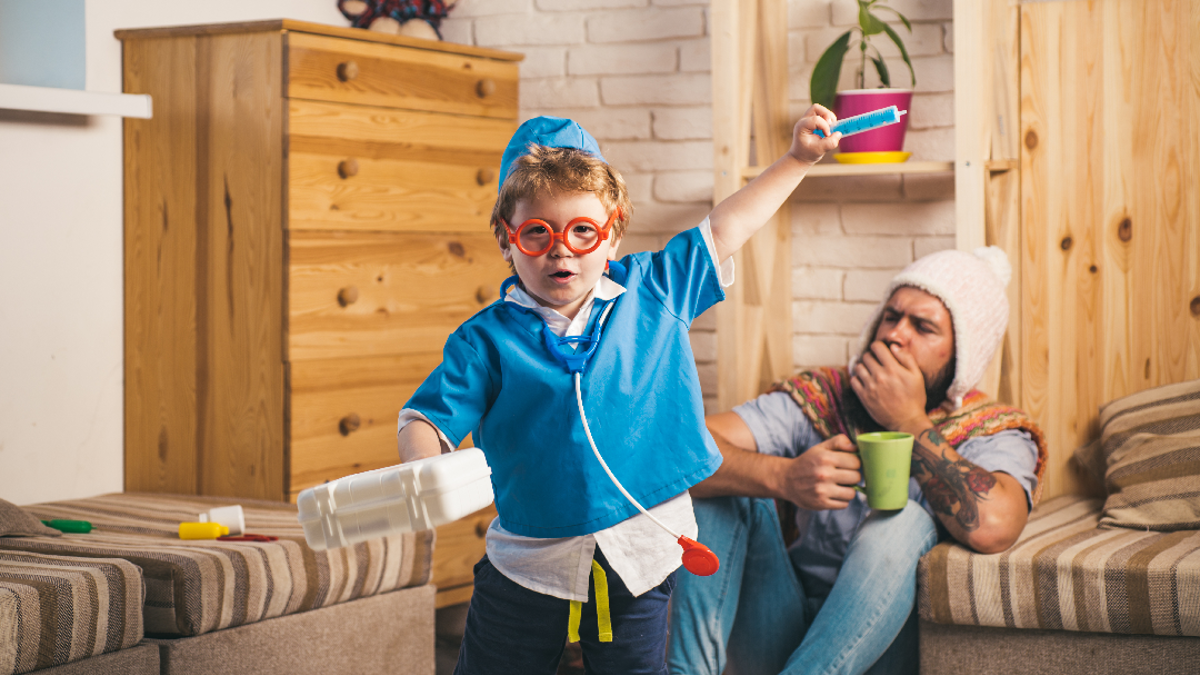The importance of play
- 0-1 Years
- 1-5 Years
- 5-11 Years
- 11-19 Years
- All Groups
- Child development and growing up
- Speech, language and communication

Some of the skills learned whilst your child is playing will turn into social skills. When you play with your child, you are strengthening your relationship with them and helping them learn social skills.
You do not need lots of toys or the latest devices to play and connect with your child. There are lots of games you can play with your child that require no toys, just you and your child!
Explore the topics on this page:
Play is important for development
Play is important for development
Playing is very important for your child’s development and wellbeing. Playing can be a great way for your child to exercise but playing also helps children learn. They learn how to interact with their surroundings, find their interests and learn about the world around them. It’s also a great way to build a relationship with your child and create memories together.
Playing with moving objects
From a very early age children like playing with things that move. They might move around themselves or play with toys that move. Playing games that involve moving around and talking can help children pay attention, understand and use language better.
Below are some suggestions of games or things to do with your baby:
Using long mobiles above your baby’s bed or play area will help them to focus their attention for a short amount of time. Spend some time showing your child the pictures hanging on the mobile. You can move them gently by blowing or tapping them. When your child’s attention begins to wander, you can tap it again.
Playing peak-a-boo or peep-bo with a teddy or another soft toy. Hide the toy from sight and let it jump out while saying “Peek-a-boo!” or “Peep-bo!”
Walking a teddy or doll along in front of your child. Talk to your child through the toy as you walk it along.
Playing with a ball. Roll the ball to your child and let it gently bump against their toes or fingers. To Encourage them to roll or kick it back you can say things like “Ready, steady, go!”, “Here it comes!” or “Catch it”.
Lifting your child up in the air and say “Weeee!” or “Up we go!”.
Playing “Row your boat”. Sit facing your child on the floor, hold hands and rock back and forth singing the rhyme.
Some games and activities you can play with your child are:
Singing “Ring of roses”. Hold hands skip in a circle as you sing the rhyme, when you sing “they all fall down”, sit or fall on the floor.
Playing ‘Simon Says’. Whoever is ‘Simon’ gives out instructions such as “Simon says... touch your toes!”. The children must only perform the action if the sentence has “Simon says” at the start. For example, if you say, “Touch your nose!” they should stand still and not touch their nose. This will encourage your child to focus and listen to the words before moving.
Playing with objects and toys
Your child can learn about the world around them and how to use things by playing with objects found around the home. They can also learn using toys that copy real objects like a doll house or toy cars. Children will learn what to do with them, how to play and behave with other children and adults.
Show your child how to play with some of their toys. For example, you can make car engine noises like “brumm brumm” while pushing a toy car or put blocks on top of each other.
Encourage your child to look for things when they have disappeared. Using toys like a ‘jack-in-the-box’, you can count as you wind the toy up. Make sure to encourage your child to look at the book as you wind it.
Let your child copy some of the things you do around the house. For example, mopping or dusting. You can let them watch you and give them a mop or duster of their own.
Have several toys like teddies or dolls and make them do different things. This could be things like making them sleep, run, jump or eat. You can encourage your child to copy your game with their toy.
Let your child explore different things in the world around them. Let them look, touch, hold, smell and listen to them. You can use objects like feathers, keys, boxes, water, etc.
Imaginative play with your child
Playing imaginary, pretend or roleplay games with your child is a fun way for them to explore the world and express themselves. Imaginative play to help improve their speech, language and communication skills. It can also help them learn more words, the meaning of the words and how to use the words when talking to others.
When playing, you can encourage your child to learn to express themselves and communicate by:
- trying not to interrupt if what they're saying doesn't make sense
- commenting on what your child is looking at and doing
- try not to ask too many questions, aim to make 4 comments for every 1 question
There are lots of ways you can play pretend with your child. You can pretend to:
- perform everyday activities like sleeping or having a tea party with empty cups
- perform everyday activities with a toy or doll like feeding a teddy bear with a spoon
- be a professional like a postman or nurse, you can encourage them to do things that those professions would do such as posting letters or putting a plaster on a sore arm
- be a animal or monster like a squirrel or a troll
- live on another planet

It can be fun to dress up or play with specific toys that match your imaginary play scenario like a toy sword. These are not essential for imaginary play. You can play using just your imagination or using simple everyday objects like cardboard boxes or tubes. The fun thing about imaginary play is that you and your child can look like or be anything they want to.
Children can be easily distracted or discouraged from playing if they are not finding it fun. There are some different ways you can help keep imaginative or pretend play fun:
- your child chooses the toy or activity
- your child controls what is happening
- copying your child or following their lead
Playing with language
Playing with language is when you play with noises and sounds. It’s a great opportunity for your child to learn about making different noises and the affect they have on other people. This can also help them learn important steps in communication such as listening, copying, taking turns, understanding words, and learning how to say them.
Some games you can play with your child:
Playing a letterbox game. Use a large piece of card with a small hole in it. Sit on the opposite side of the card from your child. Encourage your child to push things through the hole. Then encourage your child to ‘talk’ before sending it back through the hole. When they make a noise, push the toy back through the hole. Start by using 1 toy.
Playing rhyming games with actions such as ‘Down at the bottom of the deep blue sea, catching fishes. 1 – 2 – 3!’ On the count of 3, lift your child up in the air.
Playing with your hands and fingers while making noises. For example, make your hand jump like a frog, and make croaking or ribbiting noises.
Making a ‘train’ out of cardboard boxes. These cardboard boxes could be large enough for your child to sit in or small enough that they can fit in your hand. Push the cardboard boxes around the floor making a train noise like “ch-ch-ch-choo choo!”. Encourage your child to do the same.

Barrier games
A barrier game is a game where you cannot see what the other person is doing. A popular version of a barrier game is Battleships. Barrier games can help children pinpoint their misunderstanding and improve their communication skills.
To set up a barrier game you need to:
- Set up a screen between you and your child.
- Have the same materials and objects to both sides of the screen.
- Make sure your materials and objects are at the interest and age level of your child.
Once you are set up you can start playing. How to play the barrier game:
- Take turns to give instructions or make a comment about the materials and objects.
- Adjust the instructions for your child to make them simpler or more complex.
- Take away the screen when you’re done and compare the results.
There are lots of ways you can change and adapt how you play a barrier game with your child. For example, you could be colouring in 2 copies of the same picture or try to draw the same object.
Barrier games are a great opportunity to encourage your child to listen more. You can comment and praise your child for their good listening skills, especially when giving multiple or complicated instructions.
Last reviewed: 1 November, 2023
